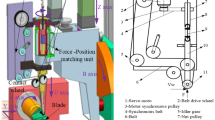Abstract
The blisk root-fillet exhibits a significant stress concentration in high-load operations, which has a significant influence on fatigue life and aerodynamic performance. To improve the static and dynamic fatigue life of the blisk in the thermal interaction environment, a method based on the anti-fatigue manufacturing principle is introduced to obtain longitudinal micromarks along the root-fillet. First, this paper proposes a belt grinding method that can obtain longitudinal micromarks, and the interference avoidance technique is analysed according to the allowance distribution and structural characteristics of the blisk root-fillet. Second, optimisation of the grinding path step is realised by means of the ‘point to point’ method, and de-noising and smoothing of the grinding vector are carried out. Finally, grinding experiment tests are carried out for the blisk root-fillet. The results demonstrate that the surface roughness is less than 0.4 μm following grinding, and the transition between the plane and fillet (blade profile—root-fillet—tenon plane) is smooth. Moreover, fine and uniform longitudinal micromarks are formed and the precision consistency is significantly improved, which proves the effectiveness of this method.
Similar content being viewed by others
References
Wang ZQ (2015) Key manufacturing technology of advanced aero-engine. Aeronautical Manuf Technol 22:34–38
Huang Y, Xiao GJ, Zou L (2016) Current situation and development trend of polishing technology for blisk. Acta Aeronautica et Astronautica Sinica 37(7):2045–2064
Zhang JF, Shi YY, Lin XJ, Li ZS (2017) Five-axis abrasive belt flap wheel polishing method for leading and trailing edges of aero-engine blade. Int J Adv Manuf Technol Doi: https://doi.org/10.1007/s00170-017-0717-z
Li HY, Li XK, Tian CC, Yang XD, Zhang Y, Liu XL, Rong YM (2017) The simulation and experimental study of glossiness formation in belt sanding and polishing processes. Int J Adv Manuf Technol 90(1–4):199–209
Williams RE, Melton VL (1998) Abrasive flow finishing of stereo lithography prototypes. Rapid Prototyp J 4(2):56–67
Gao H, YM W, YZ F, Guo DM (2015) Development of theory and technology in fluid abrasive finishing technology. J Mech Eng 51(7):174–187
Volkov DI, Koryazhkin AA (2014) Adaptive belt grinding of gas turbine blades. Russ Eng Res 34(1):37–40
Xu WX, Shi YY (2010) Automatic polishing technology of blisk robot. J Mach Des 27(7):47–50
Duan JH, Shi YY, Li XB, Zhang JF (2011) Adaptive polishing for blisk by flexible grinding head. Acta Aeronautica et Astronautica Sinica 32(5):934–940
Zhao PB, Shi YY (2014) Posture adaptive control of the flexible grinding head for blisk manufacturing. Int J Adv Manuf Technol 70(9):1989–2001
Zhao T, Shi YY, Lin XJ, Duan JH, Sun PC, Zhang J (2014) Surface roughness prediction and parameters optimization in grinding and polishing process for IBR of aero-engine. Int J Adv Manuf Technol 74(5):653–663
Xiao GJ, Huang Y (2015) Constant-load adaptive belt polishing of the weak-rigidity blisk blade. Int J Adv Manuf Technol 78(9–12):1473–1484
Xiao GJ, Huang Y (2016) Equivalent self-adaptive belt grinding for the real-R edge of an aero-engine precision-forged blade. Int J Adv Manuf Technol 83(9–12):1697–1706
Zhang L, Zhou WS, Lu L, Fan C (2015) Research on real-time control strategies of polishing force. J Northeastern University (Natural Science) 36(6):853–857
Lin XJ, Chen R, Wang ZW, Guo Y, Gao Y, Zhang XG (2015) Model restructuring about leading edge and trailing edge of precision forging blade for adaptive machining. Acta Aeronautica et Astronautica Sinica 36(5):1695–1703
Zhang L, Wang X, Zhang X G, et al. Integrated device with polishing and measurement for the blisk: China, ZL201310358708.X[P]. 2013-12-18
Zhang L, He CL, Tang HF, et al. Integrated tool system for the grinding and polishing of edge and root of blisk blade: China, ZL201410126559.9[P]. 2014-06-04
Xiao GJ, Huang Y, Yi H (2016) Experimental research on the new belt grinding method for the consistency of the blisk profile and surface precision. Acta Aeronautica et Astronautica Sinica 37(5):1667–1677
Xiao GJ, Huang Y, Yin JC (2016) An integrated polishing method for compressor blade surfaces. Int J Adv Manuf Technol 88(5–8):1723–1733
Lin XJ, Yang Y, Wu G, Gao Y, Chen Y, Liu M, Liu MX (2015) Flexible polishing technology of five-axis NC abrasive belt for blade surface. Acta Aeronautica et Astronautica Sinica 36(6):2074–2082
Sun ZJ (2014) Research on belt polishing path planning process for blisk. Jilin University, Jilin
Liu ZY (2014) Path planning for blisk blade surface belt grinding and spatial axis analysis. Chongqing University, Chongqing 2014
Wu GL, Zhang QJ (2011) An algorithm for calculating the cutter location of a six-axis CNC belt grinding machine. Mechanical Science and Technology for Aerosp Eng 30(6):973–977
Funding
This work was supported by the National Natural Science Foundation of China (Grant No. 51705047).
Author information
Authors and Affiliations
Corresponding author
Rights and permissions
About this article
Cite this article
Xiao, G., Huang, Y. & Wang, J. Path planning method for longitudinal micromarks on blisk root-fillet with belt grinding. Int J Adv Manuf Technol 95, 797–810 (2018). https://doi.org/10.1007/s00170-017-1254-5
Received:
Accepted:
Published:
Issue Date:
DOI: https://doi.org/10.1007/s00170-017-1254-5




